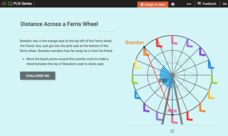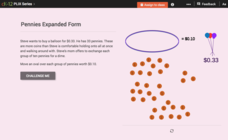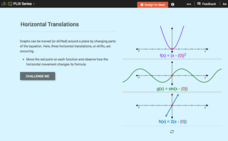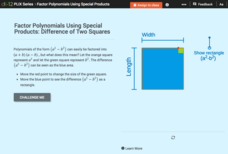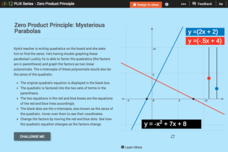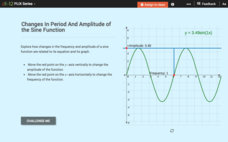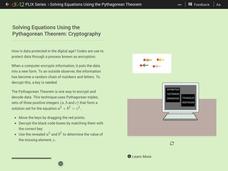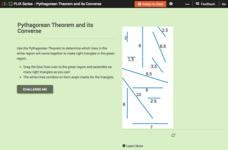CK-12 Foundation
Coterminal Angles: Full Circle
Take a terminal side for a spin. Pupils use an interactive to investigate angles of rotation that share the same terminal side. Scholars create coterminal angles and calculate what other angle sizes share the same final position.
CK-12 Foundation
Special Triangle Ratios: Special Right Triangle Ratios
Go from one side length to any other side length with special right triangles. Individuals use the interactive to investigate the ratio of sides in 45-45 and 30-60 right triangles. Scholars make generalizations about the types of special...
CK-12 Foundation
Six Trigonometric Functions and Radians: Degrees to Radians and Back Again!
How do degrees relate to radians? The interactive allows pupils to manipulate the size of an angle in a unit circle to help see that relationship. Users determine the radian measure for given degree measures of angles, realizing the...
CK-12 Foundation
Rotations in Radians: Clock Conundrum
Pupils use an interactive clock to set specific times. They apply math to an everyday task as they determine the measure of the angle formed by the hands in degrees and in radians.
CK-12 Foundation
Length of a Chord: Distance Across a Ferris Wheel
An interactive presents two friends on a ferris wheel with the task of finding the distance between the them. Pupils create the chord between the two friends and calculate its lengths using trigonometric ratios.
CK-12 Foundation
Horizontal Translations or Phase Shifts: Cosine
If cosine is shifted, how is its equation affected? Learners manipulate the graph of cosine by moving the y-intercept to different locations on the coordinate plane. Pupils determine the new equation that models the shifts.
CK-12 Foundation
Numbers in Expanded Form: Pennies Expanded Form
Beginning with a word problem that poses the question of making groups of 10 pennies to translate into a single dime, pupils are challenged to make sense of the amount of dollars 33 cents is in expanded form.
CK-12 Foundation
Horizontal Translations or Phase Shifts: Horizontal Translations
Find out what causes a function to slide. Pupils move a function along the x-axis and see the resulting change in its equation. Scholars determine the effects that the translation has on the intercepts, domain, and range of the function.
CK-12 Foundation
Horizontal Translations or Phase Shifts: Sine
Shift a trigonometric function and find its new equation. Pupils translate a sine function on a graph. The scholars determine the equation of the function that represents the translated graph and observe the connection between a...
CK-12 Foundation
Angular Velocity: 200 Meter Dash
Do curves slow runners down or help their speed? Pupils simulate a 200-meter dash to calculate the angular and linear velocity of a runner. They then determine whether the runner is faster around the curved section of the track or the...
CK-12 Foundation
Vertical Translations: Translating a Square Root Function
How does the equation of a function reflect translations? Scholars manipulate the starting point of the parent square root function before determining the new equations that result from the translations. Class members also determine the...
CK-12 Foundation
Horizontal Translations or Phase Shifts: Horizontal and Vertical Translations
It is all about the shift. Pupils translate the graph of a cubic function to different marked locations on the plane and determine the new equation that represents the shifts. The activity is designed to encourage individuals begin to...
CK-12 Foundation
Horizontal Translations or Phase Shifts: Tangent
Patterns can be shifty! Find the pattern when shifting the graph of tangent. Pupils move the graph of tangent to different locations on the coordinate plane. They observe what happens to the function and its vertical asymptotes before...
CK-12 Foundation
Equivalent Fractions: Number Line
Arrange improper fractions on a number line to determine the equivalency to whole numbers. The number line starts at -4 and ends at 4, while users must turn the improper fraction into a proper fraction in order to place it on the number...
CK-12 Foundation
Greatest Common Factor Using Lists: Tiling the Kitchen Floor
Use a combination of tiling a rectangle to find area and find the greatest common factor of the lengths of two sides and the area they create. Pupils increase and decrease the sides of the rectangle before answer five questions about...
CK-12 Foundation
Pan Flute
How can a pan flute sound one note while we hear a chord? The simulation explores sound waves, vibrations, and harmonics at the molecular level. Scholars control the pipe into which air is being blown, the length of the pipe, and which...
CK-12 Foundation
Factor Polynomials Using Special Products: Difference of Two Squares
Factoring patterns are not magic! Show your classes how to model the difference of two squares' factors using an area model. Learners manipulate the width and length of two squares to represent the polynomial a^2-b^2. They use the model...
CK-12 Foundation
Zero Product Principle: Mysterious Parabolas
Be a hero, not a zero! Help your classes understand how to solve quadratic equations with the zero product property using an animated simulation. Using the controls, scholars manipulate the zeros and watch as the function and its factors...
CK-12 Foundation
Multiplication of Rational Expressions
There's nothing irrational about this lesson. Explore the process of multiplying rational expressions through discovery. A well-designed lesson has learners factor and multiply rational expressions by dragging factors to the correct place.
CK-12 Foundation
Zero, Negative, and Fractional Exponents: Patterns with Powers
Build a foundational understanding of exponent patterns. Young scholars manipulate the bases of exponent expressions. They discover the meaning of negative exponents through their exploration.
CK-12 Foundation
Changes in Period and Amplitude of the Sine Function
How does a change in amplitude or period affect the equation of a sine function? Scholars move sliders to change the frequency and period of the sine function. The interactive displays the resulting equation, and pupils determine the...
CK-12 Foundation
Joint and Combined Variation: Variable Sliders
Learners use a pair of sliders to investigate how changes in a variable affects other variables in joint variation. A set of five challenge questions tests understanding.
CK-12 Foundation
Solving Equations Using the Pythagorean Theorem: Cryptography
Don't keep this resource a secret. Individuals learn to use the Pythagorean Theorem to find Pythagorean triples. They also see how Pythagorean triples can be useful in the field of cryptography to encrypt secret messages.
CK-12 Foundation
Pythagorean Theorem and Its Converse
To be a right triangle, or not to be — that is the question. Scholars drag line segments in an Internet application to see if they form right triangles. Once they get the results of the activity, they connect them to the converse of the...






